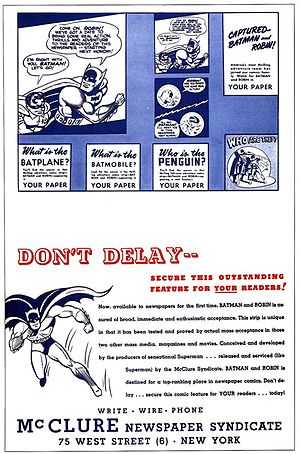McClure Newspaper Syndicate

McClure Newspaper Syndicate, the first American newspaper syndicate, introduced many American and British writers to the masses. Launched in 1884 by publisher Samuel S. McClure, it was the first successful company of its kind. It turned the marketing of comic strips, columns, book serials and other editorial matter into a large industry, and a century later, 300 syndicates were distributing 10,000 features with combined sales of $100 million a year.[1]
In 1886, McClure's college friend, John Sanborn Phillips, joined the Syndicate, and his cousin, Henry Herbert McClure, was also on the staff. Samuel McClure's brother, Robert McClure, was in charge of the London office. Allen Sangree had a position with the McClure Syndicate in 1892.
In 1914, the McClure family sold the Syndicate to J. C. Brainard, who sold it to Richard H. Waldo in 1927. After Waldo died in 1943, his widow, Adelaide P. Waldo, ran the syndicate for three years, passing it on to James L. Lenahan in 1946. Lenahan's failure to meet a due payment on the stock led to a 1952 auction when it was acquired by Ernest Cuneo, head of the Bell Syndicate-North American Newspaper Alliance group, with Louis Ruppel installed as president and editor.[2]
Writers
As America's first profitable literary syndicate, the company bought an author's work for about $150 and then sold the right to print it to a newspaper for five dollars. The company lost money during its first few years, eventually turning a profit while distributing and promoting such American authors as George Ade, John Kendrick Bangs, William Jennings Bryan, Joel Chandler Harris, William Dean Howells, Fannie Hurst, Sarah Orne Jewett, Jack London, Theodore Roosevelt, Mark Twain and Woodrow Wilson. The roster of British writers included G. K. Chesterton, Arthur Conan Doyle, Rudyard Kipling, Robert Louis Stevenson and H. G. Wells.[3]
Columnists
McClure carried the first "behind the news" column from Washington, along with columns on fashions, interior decorating and international affairs, plus Ray Tucker's "Washington Whirligig" and a column by Calvin Coolidge.
Cartoonists
One early McClure comic strip artist was Carl Thomas Anderson, who drew Herr Spiegelberger, the Amateur Cracksman beginning in 1903. In 1916, McClure purchased the Wheeler Syndicate from John Neville Wheeler. Another early comic strip artist with McClure was Percy Crosby. Commissioned a second lieutenant in the Officer Reserve Corps in 1916 and being called to active service the following year, Crosby was in training at a camp in Plattsburgh, New York. While in training, Crosby created a daily comic panel, That Rookie from the Thirteenth Squad, for the McClure Syndicate, writing and drawing it from the front in France while serving as a first lieutenant in the 77th Division, AEF. The panel was collected into his first two books, That Rookie of the Thirteenth Squad (1917) and Between Shots (1919). The syndicate also introduced newspaper readers to the art of James Montgomery Flagg and the early cartoons of Clare Victor Dwiggins and Rube Goldberg.
Editors
After employment as a newspaperman in Arizona, California and Hawaii, Harold Matson worked for the McClure Syndicate as a roving correspondent and became managing editor by 1930.[4]
Sheldon Mayer also joined the Syndicate as an editor in 1936. Some the McClure strips were reprinted during the 1930s in Funnies on Parade. In addition to comic strips and feature articles, McClure also syndicated books and stories. In 1938, Theodore Sturgeon sold his first story to the McClure Syndicate, which bought many of his early, mainstream stories before he became known for his science fiction.
In the late 1930s, the company was located at 75 West Street in New York City.
McClure comic strips
- Archie by Bob Montana
- Batman by Fred Ray
- Beauregard by Jack Davis
- Bobby Thatcher by George Storm
- The Bungle Family by Harry J. Tuthill
- Dan Flagg by Don Sherwood (originally with the McNaught Syndicate)
- Herr Spiegelberger, the Amateur Cracksman by Carl Thomas Anderson
- King Aroo by Jack Kent
- Once Upon a Time by Walter J. Enright
- Noahzark Hotel (January 12 to November 9, 1913) by Varb (Raoul Barré)
- Poor Ol' Robinson Crusoe by Everett Lowry
- Roger Lincoln, S-Man (1948-1952) by Milton Luros
- Strange as It Seems by John Hix
- Superman (1939–1967, 1977–1983) originally by Jerry Siegel and Joe Shuster
- That Rookie from the Thirteenth Squad by Percy Crosby
- There Oughta Be a Law (1944–1984) by Al Fagaly and Harry Shorten (later Frank Booth, Warren Whipple and Mort Goldberg)
- Tom Sawyer and Huck Finn by Clare Victor Dwiggins
Further reading
- Cather, Willa. The Autobiography of S.S. McClure. Lincoln; London: University of Nebraska Press, 1997.
- "Henry H. McClure, Syndicated News." The New York Times, November 23, 1938.
- Lyon, Peter. Success Story: The Life and Times of S. S. McClure. New York: Charles Scribner's Sons, 1963.
References
- ↑ Time, 1977.
- ↑ Knoll, Erwin. "McClure Syndicate Sold to Bell-NANA". Editor & Publisher, September 6, 1952.
- ↑ McClure Archives (1878-1952)
- ↑ McDowell, Edwin (January 6, 1988). "Harold Matson, Literary Agent for Major Authors". The New York Times. Retrieved November 4, 2009.